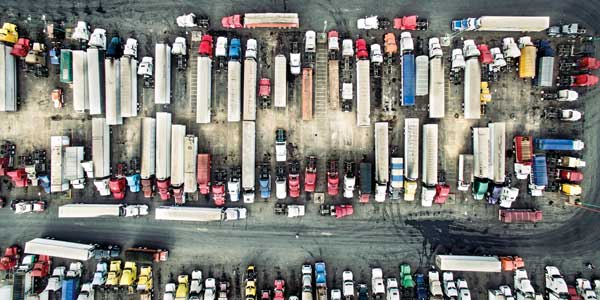In response to new EPA emission standards, diesel engine manufacturers selected one of two choices to achieve a reduction in emissions of oxides of nitrogen (NOx). They chose either an in-cylinder approach through enhanced exhaust gas recirculation (EGR) over 2007 levels, or EGR combined with an engine aftertreatment approach using selective catalytic reduction (SCR) technology.
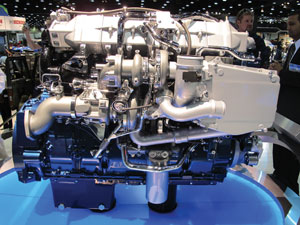
Engines used by truck manufacturers produced after Jan. 1, 2010, will have met the emission standards set by the U.S. Environmental Protection Agency. Prior to this round of emissions regulations, the EPA lowered emissions in 2004 and 2007. More recently, Washington announced plans to draft regulations for minimum fuel economy and limited carbon dioxide emissions that will go into effect in 2014. Those fuel economy and CO2 standards are now being finalized by the EPA and the National Highway Traffic Safety Administration. They’re expecting manufacturers to rely on the use of existing products and technology to achieve those goals.
What’s the difference?
Both the SCR and the enhanced EGR approaches use exhaust gas recirculation to circulate a portion of an engine’s exhaust back into the engine cylinders to achieve a reduction in emissions. Both methods also use a diesel particulate filter to remove particulate matter from the engine exhaust.
The SCR technology approach introduces a chemical called a reducing agent into the exhaust stream, and a catalytic converter to achieve the NOx reduction required by the EPA. The enhanced EGR approach recirculates a larger amount of the engine’s exhaust back into the engine where the NOx emission reduction occurs. The enhanced EGR approach is often referred to as an in-cylinder approach.
SCR technology reduces NOx by mixing the oxides of nitrogen in the exhaust gases with a solution of urea and de-ionized water commonly called diesel exhaust fluid (DEF). The exhaust passes through a decomposition tube, where the DEF is introduced through a dosing valve. The exhaust then passes through a chamber known as the SCR catalyst. Here the DEF reacts with the NOx, breaks it down, producing oxidizing ammonia. The oxidizing ammonia chemically reacts with the NOx, converting the pollutants into nitrogen, water and tiny amounts of carbon dioxide. The SCR catalyst contains a honeycomb-like substrate, which also reacts with the pollutant, converting it into nitrogen and water.
Enhanced EGR reduces NOx by increasing the amount of engine exhaust gases recirculated into the engine cylinder, slowing and cooling the combustion process. Since the exhaust gases have already combusted, they don’t burn again. These gases displace some of the normal intake, slowing and cooling the combustion process, which reduces NOx formation. This process doesn’t require introducing DEF into the exhaust stream to reduce NOx, but it does require more fuel to be injected into the diesel particulate filter for active regenerations. The increased heat created with the enhanced EGR approach can also require a greater cooling capacity for the engine.
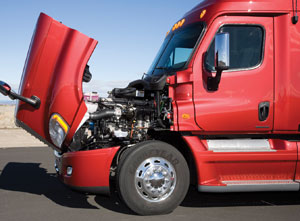
How are they working?
First, we’ll take a look at what engine manufacturers are saying about their 2010 EPA technology, then see if users agree.
Navistar chose to take “a more customer-friendly approach than other OEMs by choosing Advanced EGR” to meet emissions requirements, according to the company. The chosen technology is described as resulting in engines that treat NOx in-cylinder, and therefore require no extra effort from users since they do not require the use of DEF.
Tim Shick, director of engine sales at Navistar, said, “Our engines, of course, do not use SCR. We only use Advanced EGR. All of the emissions are handled within the engine itself. Our goal for the 2010 engines was to keep the fuel economy equal to 2007 levels. And we’re very happy to say that we were able to improve our fuel economy, particularly with our big bore products. They’re 2% to 3% better than the comparable 2007 engines. That allows us to be competitive with the SCR engines that are also offering improved fuel economy.
“We thought the fact that our engines would not need DEF would offer us a competitive advantage and were very pleased to see the fuel economy improvement. Now we can compete head-to-head with the best of the SCR engines.”
The company continues to develop its MaxxForce series with Advanced EGR. It recently announced its International PayStar heavy-duty vocational trucks are now available with MaxxForce 15 engines offering up to 550 HP and, later this year, MaxxForce 13 will be offered with up to 500 HP.
The Volvo group has chosen to eliminate NOx using SCR in its 2010 engines, which are used in both Volvo and Mack trucks. When NOx is selectively eliminated in a downstream aftertreatment chamber, the level of NOx produced by the engine can be allowed to be significantly higher than it would with no aftertreatment. This approach allows the engine itself to be tuned for maximum fuel efficiency.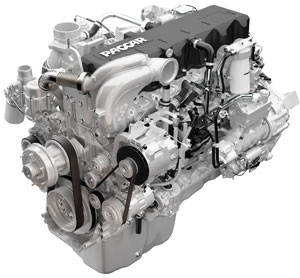
In addition, according to the manufacturer, its emissions control solution reduces driver management by eliminating the need for active regeneration of the diesel particulate filter (DPF). This was sometimes required for engines using EPA ’07 technology when passive regeneration was not enough to eliminate the soot that accumulated in the DPF.
Volvo was early in the game of 2010 EPA and California emissions certification and actually delivered 2010 certified engines in ’09. Test engines were put into fleet service in 2007. As expected, the use of SCR technology resulted in improved fuel economy. Ed Saxman, product marketing manager for drivetrains, said, “Fleets look for fuel economy and uptime from an engine. Our fuel mileage went up when we went into calendar year 2007. That’s when we came out with the ultra high fuel injection system, which is a 35,000 psi system—higher than any of the common rail pressure systems that have since been brought into the market. We saw a 3% fuel economy improvement in 2007.
“When we came out with the 2010 systems, we found that our fuel economy was 5% better than our 2007 engines. When we add this to some aerodynamic modifications, we are now claiming an 8% improvement in fuel economy for our current trucks. That’s quite an accomplishment when you realize that we’ve also reduced every regulated emission component by 99%.”
| Don’t make your own DEF! |
| Volvo’s Ed Saxman cautions fleets not to try making their own diesel exhaust fluid. He said, “We recommend that the fluid they use conforms to the ISO standard, which especially deals with cleanliness. A product that you buy as DEF has been made from de-ionized water. If you make it from tap water, the impurities in the tap water will harm the catalytic converter, and that cannot be removed through regeneration. “It was a problem in Europe when SCR was first used there. There’s a lot of urea in use, especially in farm areas. That is not diesel exhaust fluid. We haven’t actually seen a problem here yet, but it’s going to take some time before a problem will be apparent. It’s trouble we hope to avoid. You don’t make your own oil; don’t make your own diesel exhaust fluid.” |
As the company approached this year’s emissions regulations, PACCAR conducted more than 50 million miles of testing using customers in real-world applications across North America. The tests compared, among other things, the fuel economy of trucks equipped with its 2010 MX engines against the fuel economy of trucks equipped with 2007 EPA engines. The manufacturer also conducted an additional 300,000 hours of lab and track testing. Jim Cardillo, PACCAR president, pointed out the success of the company’s experience with the engine family, saying, “Over 125,000 PACCAR MX engines are successfully operating in DAF trucks globally.”
Test results, coupled with the experiences of operators, consistently demonstrated a 3% to 5% improvement, not counting the cost of diesel emission fluid, over the company’s 2007 counterparts. Olen Hunter, director of sales for PACCAR Leasing, (PacLease), indicated that, even extrapolating a conservative estimate of a 3% net improvement, a fleet can expect big savings over time.
Stotesbury Transfer is a liquid food hauler based in Kitchener, Ont., that runs Kenworths. Owners Bryan and Bruce Stotesbury appreciate the improved fuel economy from their two Kenworth T800s equipped with new PACCAR MX engines. The fleet’s over-the-road tractors pull quad-axle trailers with combination weights of 128,000 lbs. or more.
“We’re getting about a two-tenths MPG improvement with the PACCAR MX engine in our pick-up and delivery milk tanker and a two-tenths to four-tenths MPG improvement in our comparably spec’ed over-the-road fleet truck,” Bruce said. “We expect those numbers to increase over time as we continue to break in the engines. I believe our fuel economy would be even better if we were hauling in standard configurations.”
Cummins introduced its 2010 EPA compliant on-engine lineup at the Mid-America Trucking Show in March of 2009—almost a full year before the tight emissions regulations went into effect. At that time, the company predicted fuel economy gains of up to 5% would be realized when evaluated against the company’s comparable 2007 engines. Steve Charlton, vice president of heavy-duty engineering, said, “Our 2010 heavy-duty engines have a large ‘sweet spot,’ which means that these engines are extraordinarily driver-friendly. Fuel economy gains can be realized with even the most inexperienced driver and, at the same time, the engines deliver performance that drivers will love.”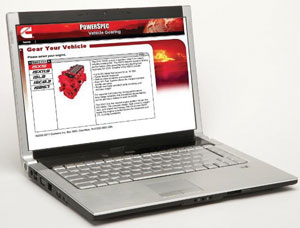
Currently, Cummins customers have been satisfied with increased fuel economy, as well as the performance and driveability of their EPA 2010 engines. The company promised a fuel economy improvement of 6% on the ISX15 compared to its 2007 model, and customers are realizing this in their daily operations with many citing even better results. Its MidRange products, the ISL9, ISC8.3 and ISB6.7, are also realizing fuel economy gains of up to 3% better MPG.
SCR technology was not new for Cummins, as Cummins Emissions Solutions (CES) has been building these systems for European markets years in advance of 2010. Over 300,000 SCR systems have been built and shipped by CES to customers around the globe.
The concern fleets voice regarding the availability of diesel exhaust fluid has turned out to have been unwarranted. The infrastructure for supplying DEF is expanding across North America. A very helpful resource is discoverdef.com, where a comprehensive DEF retail locator is continually updated and added.
Not surprisingly, Daimler Trucks North America (DTNA) drew on its European experiences and chose SCR as the emissions solution for its line of Detroit Diesel engines. Detroit Diesel’s BlueTec 1-Box Configuration combines the diesel oxidation catalyst (DOC), diesel particulate filter (DPF) and SCR catalyst into one component. This concept, according to the manufacturer, improves fuel economy by lowering engine back pressure.
And the theory is apparently working. Brad Williamson, director of engine and component marketing, said, “Our 2010 DD 15 increased fuel economy by 5% over a 2007 Series 60 engine. Customers are more than satisfied with the fuel economy they’re getting. We have some customers getting upwards of 6%. Of course, it depends on the customer and the application. We have one customer who replaced a number of 2004 engines with 2010 model engines. They reported that they are getting over 10% better fuel economy.”
Williamson also reports that performance and reliability have been very good to date. He said, “If you look at the SCR system by itself, there really are no issues. You get in, make sure it has diesel exhaust fluid, and you drive. And they perform very well. Our torque curve is very flat. You can pull all the way down to 1000 RPM and up into the 1500 or 1600 RPM range. Every customer I’ve talked to is very impressed with how strong and quiet the engine is.”
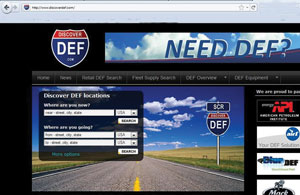
From the fleets
And the users agree! Darry Stuart, president and CEO of DWS Fleet Management Services, said, “Performance has been much better than we feared. In fact, the performance they deliver certainly does not support all the complaining we did earlier.
“The new engines have offered very few problems. Performance is very good. We’ve found them to be trouble-free. The only problem that users have found is with the cost, and there still is some concern about diesel exhaust fluid. As far as operations goes, they have offered very little challenge. It really has been a non-event.”
Art Trahan, a senior manager, Ryder Systems, who works closely with engine manufacturers on emissions, said, “I almost feel that we should have skipped ‘07 and moved right into 2010 engines. These new engines are delivering 3% to 5% better fuel economy, as manufacturers told us they would.
“Performance has come back, eliminating driver complaints about the lack of power and torque. Start ability and grade ability is acceptable as long as you specify the engine and drivetrain for the job. We’ve not had any complaints as far as power is concerned. So far it’s been a good story.”
Can leasing help?
Olen Hunter, director of sales for PACCAR Leasing, (PacLease) thinks it can.
“The choices in engine technology available to truck and private fleet operators have never been so different, and making the right choice has never been so important for companies to control their fleet operating costs, get more mileage out of the engines and gain a competitive edge,” he said.
According to Hunter, the 2010 engine emission standards offer good reasons why fleets might want to consider full-service leasing from a company that understands the performance of 2010 EPA-compliant engines. PacLease, which has a strong relationship with engine manufacturers and close ties to truck manufacturers Kenworth and Peterbilt, can help companies make informed choices about trucks with 2010 engines.
“Regardless which 2010 engine operators choose, they will see a price increase in the engine. By leasing their trucks, companies can spread that cost over time,” Hunter said. “Over a typical 6 1/2-year lease term, a $9,000 price increase for the engine will increase the monthly lease payment by about $120.
“Leasing can help take the guesswork out of specifying and servicing 2010 engines,” Hunter said. “Plus, the leasing company can handle any warranty issues and take over any risk associated with truck resale values.”


